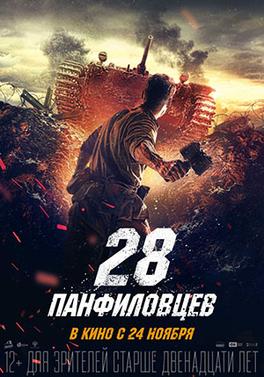“Panfilov’s 28 Men” (also known as “Panfilov’s 28) is a Russian film about the legendary defense of Moscow by members of the 316th Rifle Division which was commanded by Gen. Ivan Panfilov. The 28 men were collectively awarded the Hero of the Soviet Union.
The movie opens on Nov. 14, 1941 at a bleak moment for the Soviet Union. Operation Barbarossa has been spectacularly successful and the Wehrmacht is closing in on Moscow. The Red Army is fighting desperately to slow down the Germans. The 28 are all that is left from three companies. They prepare by training using a wooden tank (ironically as you will read later). As the men throw snowballs at the tank, their officers discuss the odds against them and the plan to block the 11th Panzer Division. They march to the site and dig foxholes and trenches. They withstand a heavy bombardment that shows you how soldiers can survive when they are dug in. Soon German tanks and infantry approach. From here the movie is a last stand. The Soviets fight desperately with anti-tank artillery, machine guns, Molotov cocktails, and grenades. Some of the men are armed with PTRD-41 anti-tank rifles. The unit is led by commissar Klochkov (Aleksey Morozov). He inspires the men to fight to the end.
“Panfilov’s 28 Men” is a good pure combat film. It doesn’t spend a lot of time on background. But we do get to know the men as generic, stoic soldiers. On the march, they discuss the Seven Samurai and the 300 Spartans. The banter is realistic, although there is no dysfunction and no one grumbles about the suicidal nature of their mission. The acting is adequate for a film that is focused on action. The cast is sincere, but no one stands out. They are all warriors who give the Germans hell. The movie is not a Soviet style propaganda piece, but it is clearly meant as an homage to the 28 and not interested in depicting any of the 28 as anything else but patriots. As evidence of the goal, the main character is a commissar who explains to the men what they are fighting for.
The main reason for seeing the movie, besides learning about one of the most famous legends of the Great Patriotic War, is the combat. It is not combat porn of the Korean variety. The bombardments are realistically horrific. The cinematography puts you with them in the trenches. The fighting is intense and there is a lot of it. The soldiers use a variety of authentic weapons which is a treat for war movie lovers who care about weaponry. It’s a good tank movie. Besides the ironic use of a full-scale wooden replica that was moved on a sled, there were 1:16 scale models that are better than CGI. Unfortunately, the movie makes the common mistake of having the tanks less than capable. They rarely use their machine guns or even their main guns. They are too easily taken out. If the movie was realistic, the Germans would have easily broken through the Soviet line. But then we wouldn’t have had a heroic last stand. And we wouldn’t have gotten the satisfaction of Nazis being slaughtered. The tanks do little to stop the 28 from mowing down the infantry. The deaths are not of the touchdown signaling type, thankfully. This is not the Russian equivalent of “Battle of the Bulge”. Instead, it is closest to “9th Company” in its combat. It is not as good as that movie because most of the characters are not recognizable and although you care about the group, you don’t care about the individuals.
“Panfilov’s 28 Men” is an entertaining combat movie. It is just for guys as there are no female characters. It is an excellent example of a movie that perpetuates a legend and is not interested in historical revisionism. By the time the movie was made, scholarship and evidence from opened Soviet records had proved that the story of the 28 was made up. It originated in an article in a Red Army newspaper at the time of the Battle of Moscow. That should have been a major red flag that the story was invented for morale purposes. In spite of the fact that the movie could easily be proved historically inaccurate, the culture minister snippily defended it as telling about “a sacred legend that shouldn’t be interfered with. People that do that are filthy scum”. Since I am not really interested in the true story of Panfilov’s 28 Guardsmen (mainly because there is no story), I have no problem with the historical license taken here. I would assume most Russian viewers were aware that they were watching a movie about a legend.
GRADE = B+


_poster.jpg)